HRM302 - Managing Change: Strategies, Roles, and Assessment Report
VerifiedAdded on 2023/05/28
|8
|2125
|415
Report
AI Summary
This report addresses key aspects of managing change within an organizational context. It begins by exploring strategies and motivators that can be employed to mitigate resistance to change among workers, emphasizing the importance of open communication, employee involvement, training, and resource provision. The report then delves into the crucial role of the leader or change agent, outlining their operational, collaborative, and advisory functions in guiding change initiatives, including setting objectives, managing conflicts, and motivating employees. Finally, the report examines how senior management teams can assess the success of their change management strategies, highlighting methods such as feedback collection, 360-degree appraisals, the use of Kotter's 8-step model, and ongoing monitoring and assessment to ensure that change initiatives align with organizational goals and objectives. The report uses references to support its claims and is designed to fulfill the requirements of the assignment brief.
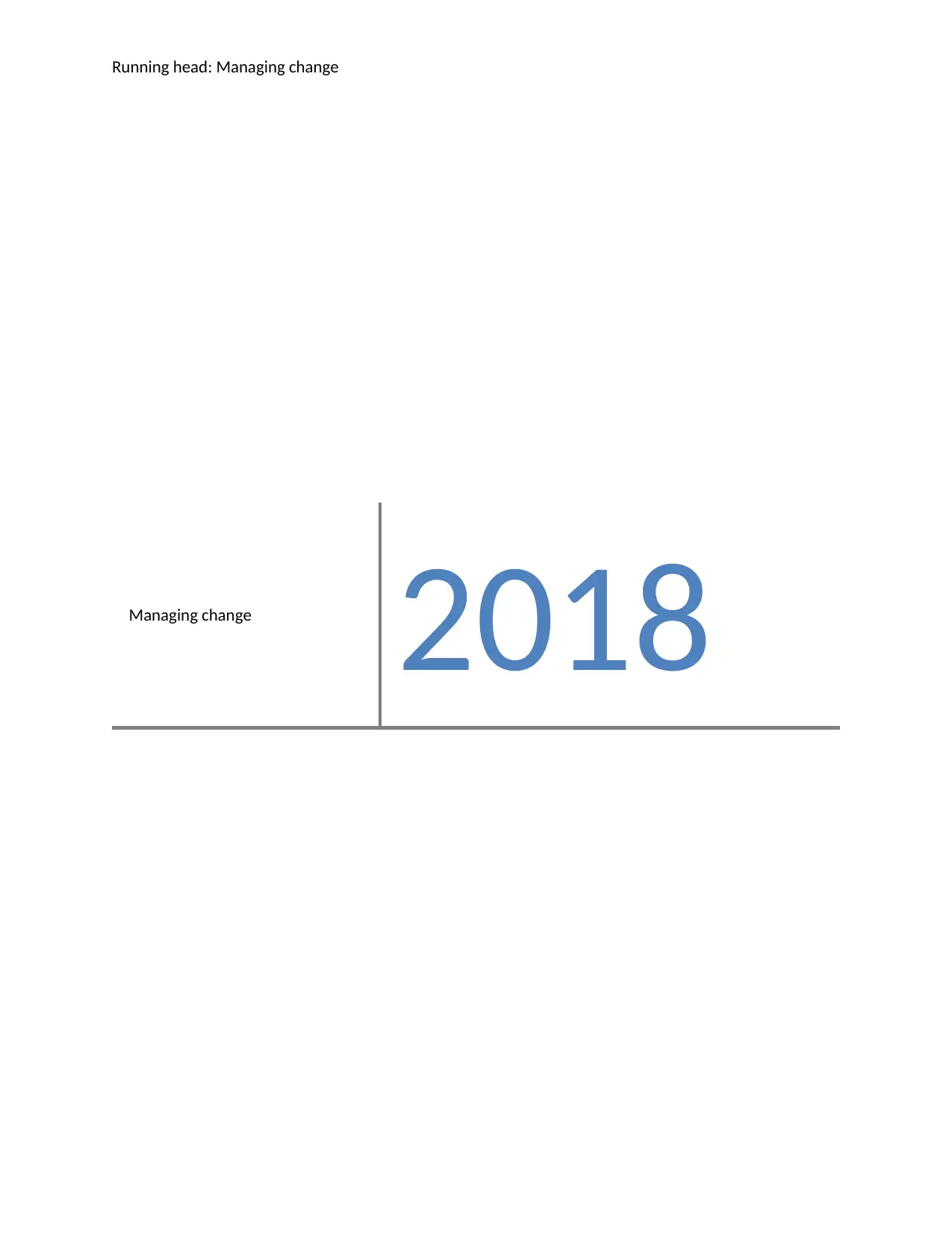
Running head: Managing change
Managing change
2018
Managing change
2018
Paraphrase This Document
Need a fresh take? Get an instant paraphrase of this document with our AI Paraphraser
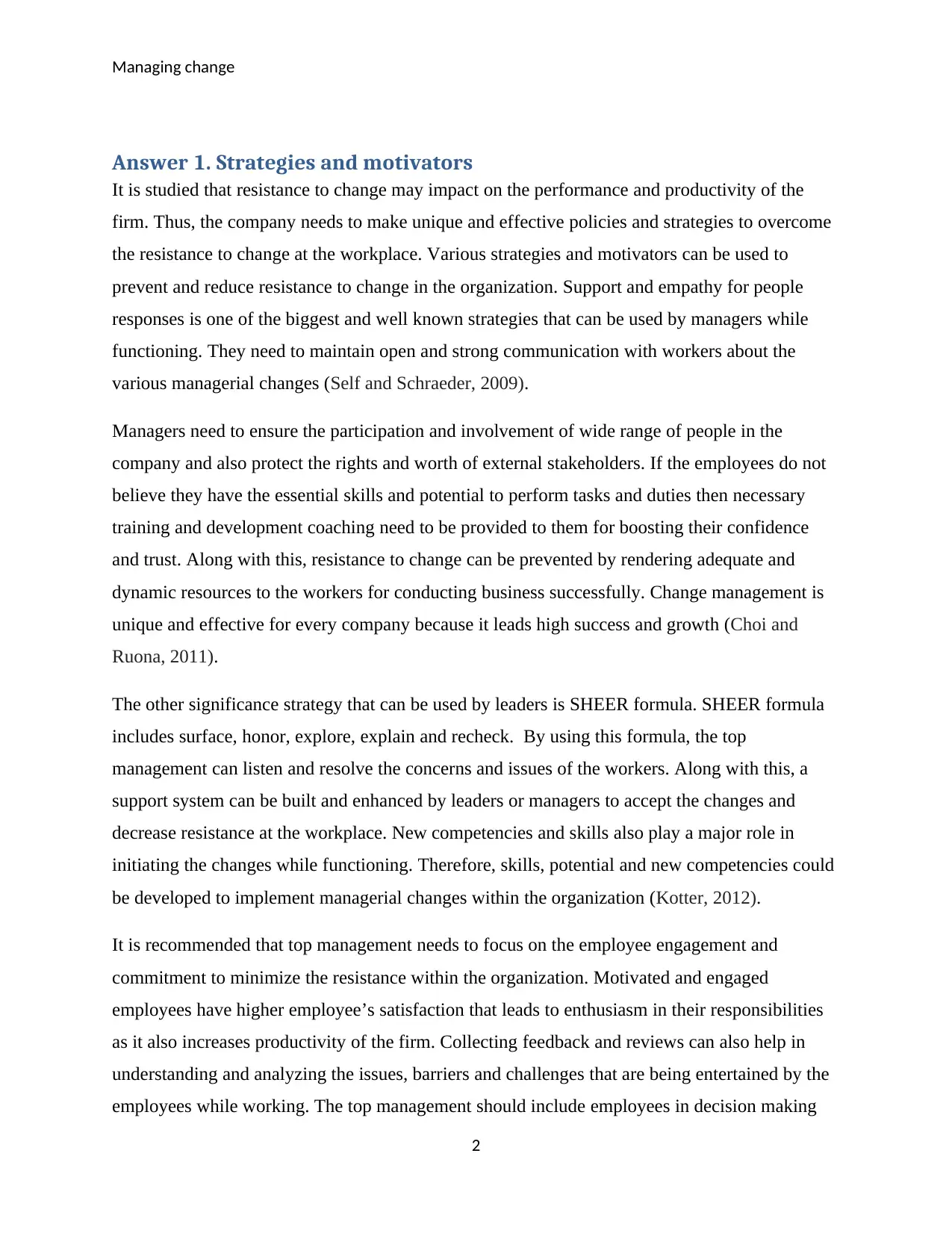
Managing change
Answer 1. Strategies and motivators
It is studied that resistance to change may impact on the performance and productivity of the
firm. Thus, the company needs to make unique and effective policies and strategies to overcome
the resistance to change at the workplace. Various strategies and motivators can be used to
prevent and reduce resistance to change in the organization. Support and empathy for people
responses is one of the biggest and well known strategies that can be used by managers while
functioning. They need to maintain open and strong communication with workers about the
various managerial changes (Self and Schraeder, 2009).
Managers need to ensure the participation and involvement of wide range of people in the
company and also protect the rights and worth of external stakeholders. If the employees do not
believe they have the essential skills and potential to perform tasks and duties then necessary
training and development coaching need to be provided to them for boosting their confidence
and trust. Along with this, resistance to change can be prevented by rendering adequate and
dynamic resources to the workers for conducting business successfully. Change management is
unique and effective for every company because it leads high success and growth (Choi and
Ruona, 2011).
The other significance strategy that can be used by leaders is SHEER formula. SHEER formula
includes surface, honor, explore, explain and recheck. By using this formula, the top
management can listen and resolve the concerns and issues of the workers. Along with this, a
support system can be built and enhanced by leaders or managers to accept the changes and
decrease resistance at the workplace. New competencies and skills also play a major role in
initiating the changes while functioning. Therefore, skills, potential and new competencies could
be developed to implement managerial changes within the organization (Kotter, 2012).
It is recommended that top management needs to focus on the employee engagement and
commitment to minimize the resistance within the organization. Motivated and engaged
employees have higher employee’s satisfaction that leads to enthusiasm in their responsibilities
as it also increases productivity of the firm. Collecting feedback and reviews can also help in
understanding and analyzing the issues, barriers and challenges that are being entertained by the
employees while working. The top management should include employees in decision making
2
Answer 1. Strategies and motivators
It is studied that resistance to change may impact on the performance and productivity of the
firm. Thus, the company needs to make unique and effective policies and strategies to overcome
the resistance to change at the workplace. Various strategies and motivators can be used to
prevent and reduce resistance to change in the organization. Support and empathy for people
responses is one of the biggest and well known strategies that can be used by managers while
functioning. They need to maintain open and strong communication with workers about the
various managerial changes (Self and Schraeder, 2009).
Managers need to ensure the participation and involvement of wide range of people in the
company and also protect the rights and worth of external stakeholders. If the employees do not
believe they have the essential skills and potential to perform tasks and duties then necessary
training and development coaching need to be provided to them for boosting their confidence
and trust. Along with this, resistance to change can be prevented by rendering adequate and
dynamic resources to the workers for conducting business successfully. Change management is
unique and effective for every company because it leads high success and growth (Choi and
Ruona, 2011).
The other significance strategy that can be used by leaders is SHEER formula. SHEER formula
includes surface, honor, explore, explain and recheck. By using this formula, the top
management can listen and resolve the concerns and issues of the workers. Along with this, a
support system can be built and enhanced by leaders or managers to accept the changes and
decrease resistance at the workplace. New competencies and skills also play a major role in
initiating the changes while functioning. Therefore, skills, potential and new competencies could
be developed to implement managerial changes within the organization (Kotter, 2012).
It is recommended that top management needs to focus on the employee engagement and
commitment to minimize the resistance within the organization. Motivated and engaged
employees have higher employee’s satisfaction that leads to enthusiasm in their responsibilities
as it also increases productivity of the firm. Collecting feedback and reviews can also help in
understanding and analyzing the issues, barriers and challenges that are being entertained by the
employees while working. The top management should include employees in decision making
2
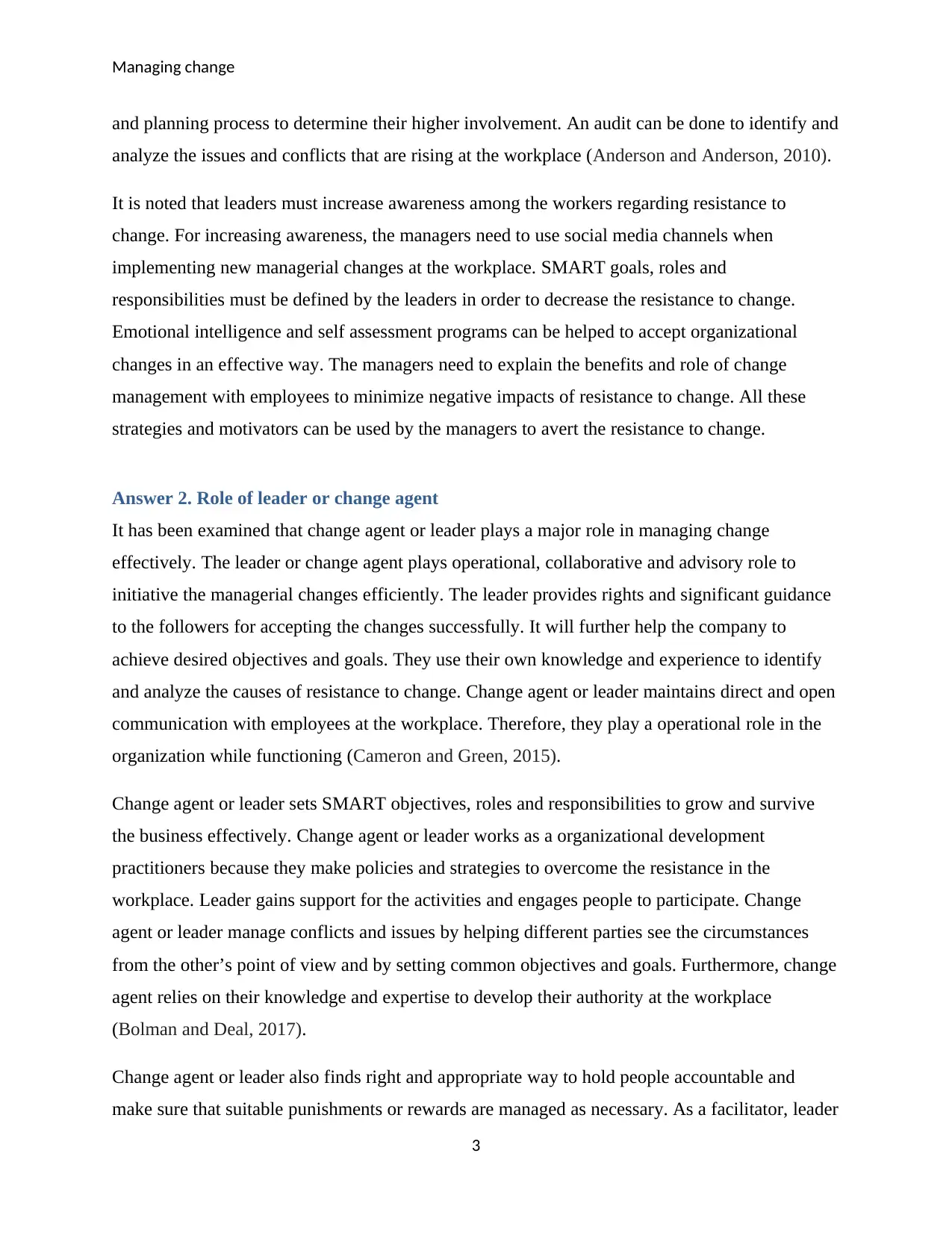
Managing change
and planning process to determine their higher involvement. An audit can be done to identify and
analyze the issues and conflicts that are rising at the workplace (Anderson and Anderson, 2010).
It is noted that leaders must increase awareness among the workers regarding resistance to
change. For increasing awareness, the managers need to use social media channels when
implementing new managerial changes at the workplace. SMART goals, roles and
responsibilities must be defined by the leaders in order to decrease the resistance to change.
Emotional intelligence and self assessment programs can be helped to accept organizational
changes in an effective way. The managers need to explain the benefits and role of change
management with employees to minimize negative impacts of resistance to change. All these
strategies and motivators can be used by the managers to avert the resistance to change.
Answer 2. Role of leader or change agent
It has been examined that change agent or leader plays a major role in managing change
effectively. The leader or change agent plays operational, collaborative and advisory role to
initiative the managerial changes efficiently. The leader provides rights and significant guidance
to the followers for accepting the changes successfully. It will further help the company to
achieve desired objectives and goals. They use their own knowledge and experience to identify
and analyze the causes of resistance to change. Change agent or leader maintains direct and open
communication with employees at the workplace. Therefore, they play a operational role in the
organization while functioning (Cameron and Green, 2015).
Change agent or leader sets SMART objectives, roles and responsibilities to grow and survive
the business effectively. Change agent or leader works as a organizational development
practitioners because they make policies and strategies to overcome the resistance in the
workplace. Leader gains support for the activities and engages people to participate. Change
agent or leader manage conflicts and issues by helping different parties see the circumstances
from the other’s point of view and by setting common objectives and goals. Furthermore, change
agent relies on their knowledge and expertise to develop their authority at the workplace
(Bolman and Deal, 2017).
Change agent or leader also finds right and appropriate way to hold people accountable and
make sure that suitable punishments or rewards are managed as necessary. As a facilitator, leader
3
and planning process to determine their higher involvement. An audit can be done to identify and
analyze the issues and conflicts that are rising at the workplace (Anderson and Anderson, 2010).
It is noted that leaders must increase awareness among the workers regarding resistance to
change. For increasing awareness, the managers need to use social media channels when
implementing new managerial changes at the workplace. SMART goals, roles and
responsibilities must be defined by the leaders in order to decrease the resistance to change.
Emotional intelligence and self assessment programs can be helped to accept organizational
changes in an effective way. The managers need to explain the benefits and role of change
management with employees to minimize negative impacts of resistance to change. All these
strategies and motivators can be used by the managers to avert the resistance to change.
Answer 2. Role of leader or change agent
It has been examined that change agent or leader plays a major role in managing change
effectively. The leader or change agent plays operational, collaborative and advisory role to
initiative the managerial changes efficiently. The leader provides rights and significant guidance
to the followers for accepting the changes successfully. It will further help the company to
achieve desired objectives and goals. They use their own knowledge and experience to identify
and analyze the causes of resistance to change. Change agent or leader maintains direct and open
communication with employees at the workplace. Therefore, they play a operational role in the
organization while functioning (Cameron and Green, 2015).
Change agent or leader sets SMART objectives, roles and responsibilities to grow and survive
the business effectively. Change agent or leader works as a organizational development
practitioners because they make policies and strategies to overcome the resistance in the
workplace. Leader gains support for the activities and engages people to participate. Change
agent or leader manage conflicts and issues by helping different parties see the circumstances
from the other’s point of view and by setting common objectives and goals. Furthermore, change
agent relies on their knowledge and expertise to develop their authority at the workplace
(Bolman and Deal, 2017).
Change agent or leader also finds right and appropriate way to hold people accountable and
make sure that suitable punishments or rewards are managed as necessary. As a facilitator, leader
3
⊘ This is a preview!⊘
Do you want full access?
Subscribe today to unlock all pages.

Trusted by 1+ million students worldwide
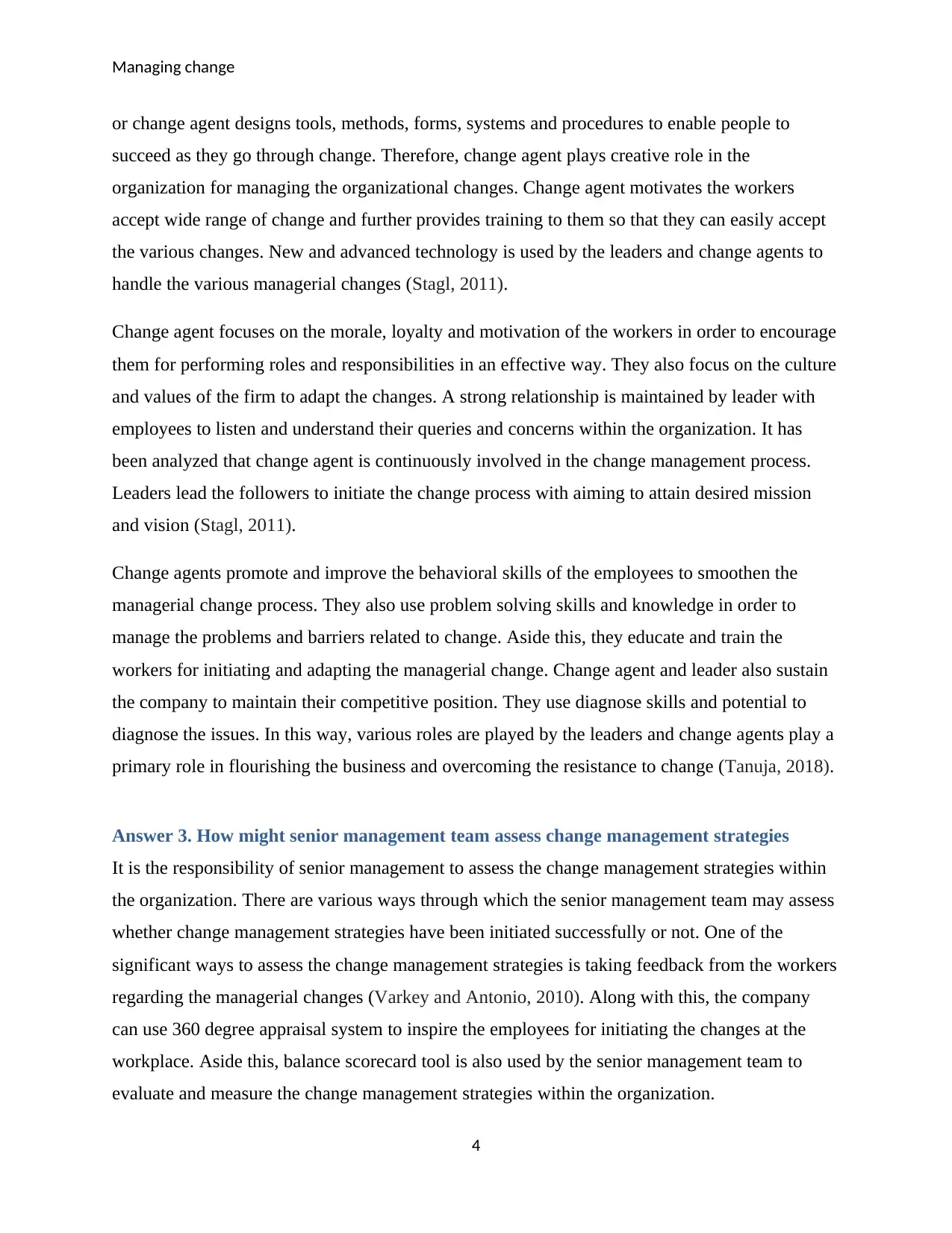
Managing change
or change agent designs tools, methods, forms, systems and procedures to enable people to
succeed as they go through change. Therefore, change agent plays creative role in the
organization for managing the organizational changes. Change agent motivates the workers
accept wide range of change and further provides training to them so that they can easily accept
the various changes. New and advanced technology is used by the leaders and change agents to
handle the various managerial changes (Stagl, 2011).
Change agent focuses on the morale, loyalty and motivation of the workers in order to encourage
them for performing roles and responsibilities in an effective way. They also focus on the culture
and values of the firm to adapt the changes. A strong relationship is maintained by leader with
employees to listen and understand their queries and concerns within the organization. It has
been analyzed that change agent is continuously involved in the change management process.
Leaders lead the followers to initiate the change process with aiming to attain desired mission
and vision (Stagl, 2011).
Change agents promote and improve the behavioral skills of the employees to smoothen the
managerial change process. They also use problem solving skills and knowledge in order to
manage the problems and barriers related to change. Aside this, they educate and train the
workers for initiating and adapting the managerial change. Change agent and leader also sustain
the company to maintain their competitive position. They use diagnose skills and potential to
diagnose the issues. In this way, various roles are played by the leaders and change agents play a
primary role in flourishing the business and overcoming the resistance to change (Tanuja, 2018).
Answer 3. How might senior management team assess change management strategies
It is the responsibility of senior management to assess the change management strategies within
the organization. There are various ways through which the senior management team may assess
whether change management strategies have been initiated successfully or not. One of the
significant ways to assess the change management strategies is taking feedback from the workers
regarding the managerial changes (Varkey and Antonio, 2010). Along with this, the company
can use 360 degree appraisal system to inspire the employees for initiating the changes at the
workplace. Aside this, balance scorecard tool is also used by the senior management team to
evaluate and measure the change management strategies within the organization.
4
or change agent designs tools, methods, forms, systems and procedures to enable people to
succeed as they go through change. Therefore, change agent plays creative role in the
organization for managing the organizational changes. Change agent motivates the workers
accept wide range of change and further provides training to them so that they can easily accept
the various changes. New and advanced technology is used by the leaders and change agents to
handle the various managerial changes (Stagl, 2011).
Change agent focuses on the morale, loyalty and motivation of the workers in order to encourage
them for performing roles and responsibilities in an effective way. They also focus on the culture
and values of the firm to adapt the changes. A strong relationship is maintained by leader with
employees to listen and understand their queries and concerns within the organization. It has
been analyzed that change agent is continuously involved in the change management process.
Leaders lead the followers to initiate the change process with aiming to attain desired mission
and vision (Stagl, 2011).
Change agents promote and improve the behavioral skills of the employees to smoothen the
managerial change process. They also use problem solving skills and knowledge in order to
manage the problems and barriers related to change. Aside this, they educate and train the
workers for initiating and adapting the managerial change. Change agent and leader also sustain
the company to maintain their competitive position. They use diagnose skills and potential to
diagnose the issues. In this way, various roles are played by the leaders and change agents play a
primary role in flourishing the business and overcoming the resistance to change (Tanuja, 2018).
Answer 3. How might senior management team assess change management strategies
It is the responsibility of senior management to assess the change management strategies within
the organization. There are various ways through which the senior management team may assess
whether change management strategies have been initiated successfully or not. One of the
significant ways to assess the change management strategies is taking feedback from the workers
regarding the managerial changes (Varkey and Antonio, 2010). Along with this, the company
can use 360 degree appraisal system to inspire the employees for initiating the changes at the
workplace. Aside this, balance scorecard tool is also used by the senior management team to
evaluate and measure the change management strategies within the organization.
4
Paraphrase This Document
Need a fresh take? Get an instant paraphrase of this document with our AI Paraphraser
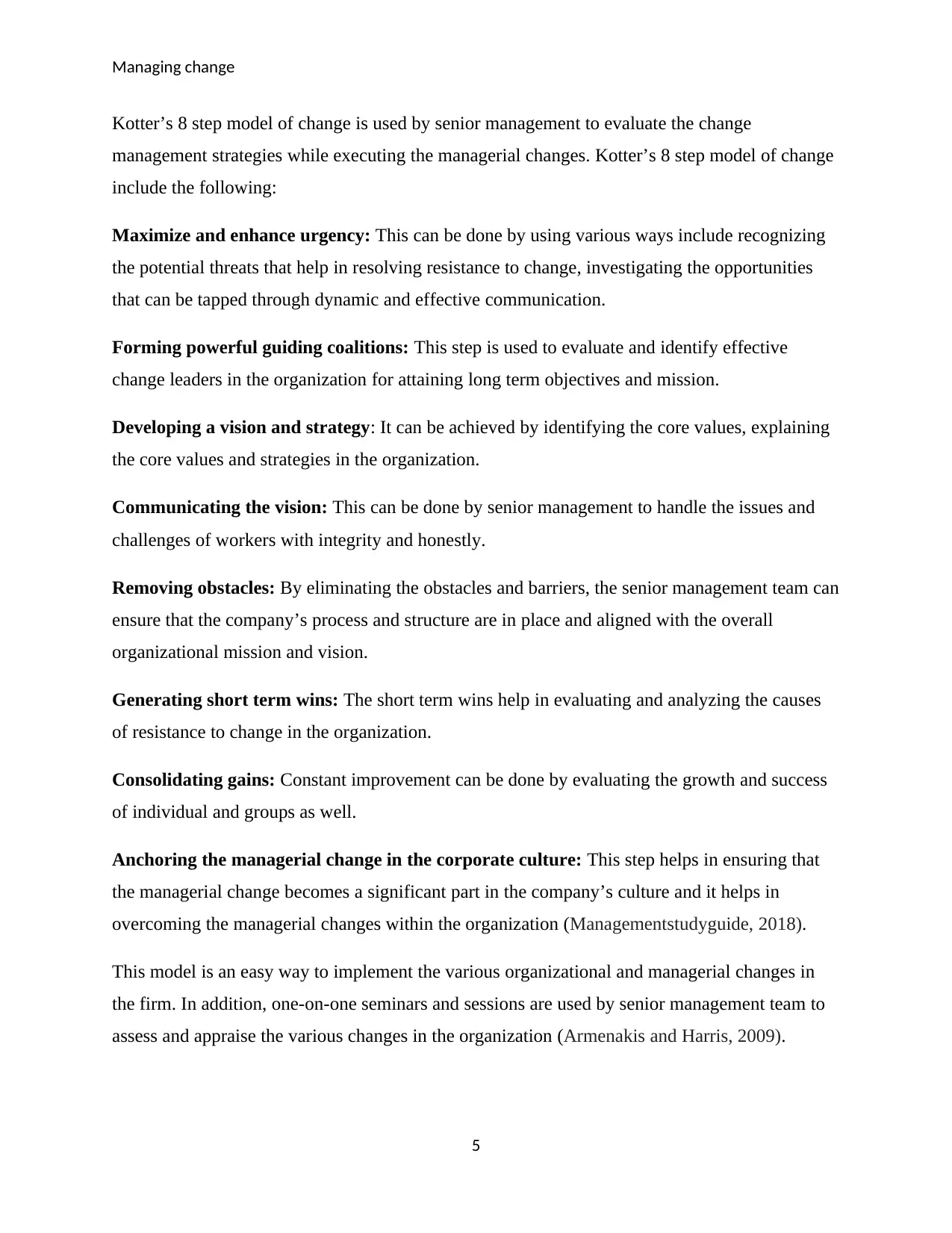
Managing change
Kotter’s 8 step model of change is used by senior management to evaluate the change
management strategies while executing the managerial changes. Kotter’s 8 step model of change
include the following:
Maximize and enhance urgency: This can be done by using various ways include recognizing
the potential threats that help in resolving resistance to change, investigating the opportunities
that can be tapped through dynamic and effective communication.
Forming powerful guiding coalitions: This step is used to evaluate and identify effective
change leaders in the organization for attaining long term objectives and mission.
Developing a vision and strategy: It can be achieved by identifying the core values, explaining
the core values and strategies in the organization.
Communicating the vision: This can be done by senior management to handle the issues and
challenges of workers with integrity and honestly.
Removing obstacles: By eliminating the obstacles and barriers, the senior management team can
ensure that the company’s process and structure are in place and aligned with the overall
organizational mission and vision.
Generating short term wins: The short term wins help in evaluating and analyzing the causes
of resistance to change in the organization.
Consolidating gains: Constant improvement can be done by evaluating the growth and success
of individual and groups as well.
Anchoring the managerial change in the corporate culture: This step helps in ensuring that
the managerial change becomes a significant part in the company’s culture and it helps in
overcoming the managerial changes within the organization (Managementstudyguide, 2018).
This model is an easy way to implement the various organizational and managerial changes in
the firm. In addition, one-on-one seminars and sessions are used by senior management team to
assess and appraise the various changes in the organization (Armenakis and Harris, 2009).
5
Kotter’s 8 step model of change is used by senior management to evaluate the change
management strategies while executing the managerial changes. Kotter’s 8 step model of change
include the following:
Maximize and enhance urgency: This can be done by using various ways include recognizing
the potential threats that help in resolving resistance to change, investigating the opportunities
that can be tapped through dynamic and effective communication.
Forming powerful guiding coalitions: This step is used to evaluate and identify effective
change leaders in the organization for attaining long term objectives and mission.
Developing a vision and strategy: It can be achieved by identifying the core values, explaining
the core values and strategies in the organization.
Communicating the vision: This can be done by senior management to handle the issues and
challenges of workers with integrity and honestly.
Removing obstacles: By eliminating the obstacles and barriers, the senior management team can
ensure that the company’s process and structure are in place and aligned with the overall
organizational mission and vision.
Generating short term wins: The short term wins help in evaluating and analyzing the causes
of resistance to change in the organization.
Consolidating gains: Constant improvement can be done by evaluating the growth and success
of individual and groups as well.
Anchoring the managerial change in the corporate culture: This step helps in ensuring that
the managerial change becomes a significant part in the company’s culture and it helps in
overcoming the managerial changes within the organization (Managementstudyguide, 2018).
This model is an easy way to implement the various organizational and managerial changes in
the firm. In addition, one-on-one seminars and sessions are used by senior management team to
assess and appraise the various changes in the organization (Armenakis and Harris, 2009).
5

Managing change
An audit is also done by the top management to review whether change management strategies
have been initiated effectively or not. Monitoring and assessment are also conducted to judge
and evaluate the effectiveness and success of managerial changes at the workplace. Assessment
and monitoring also help in analyzing whether the organization has met its targets and goals or
not. In addition, change agent or leader is appointed by the senior management team to review
and analyze the performance and productivity of the employees. Change management activities
are tracked and training tests are taken by the senior management team to judge the success and
progress of change management strategies (Brisson-Banks, 2010).
6
An audit is also done by the top management to review whether change management strategies
have been initiated effectively or not. Monitoring and assessment are also conducted to judge
and evaluate the effectiveness and success of managerial changes at the workplace. Assessment
and monitoring also help in analyzing whether the organization has met its targets and goals or
not. In addition, change agent or leader is appointed by the senior management team to review
and analyze the performance and productivity of the employees. Change management activities
are tracked and training tests are taken by the senior management team to judge the success and
progress of change management strategies (Brisson-Banks, 2010).
6
⊘ This is a preview!⊘
Do you want full access?
Subscribe today to unlock all pages.

Trusted by 1+ million students worldwide
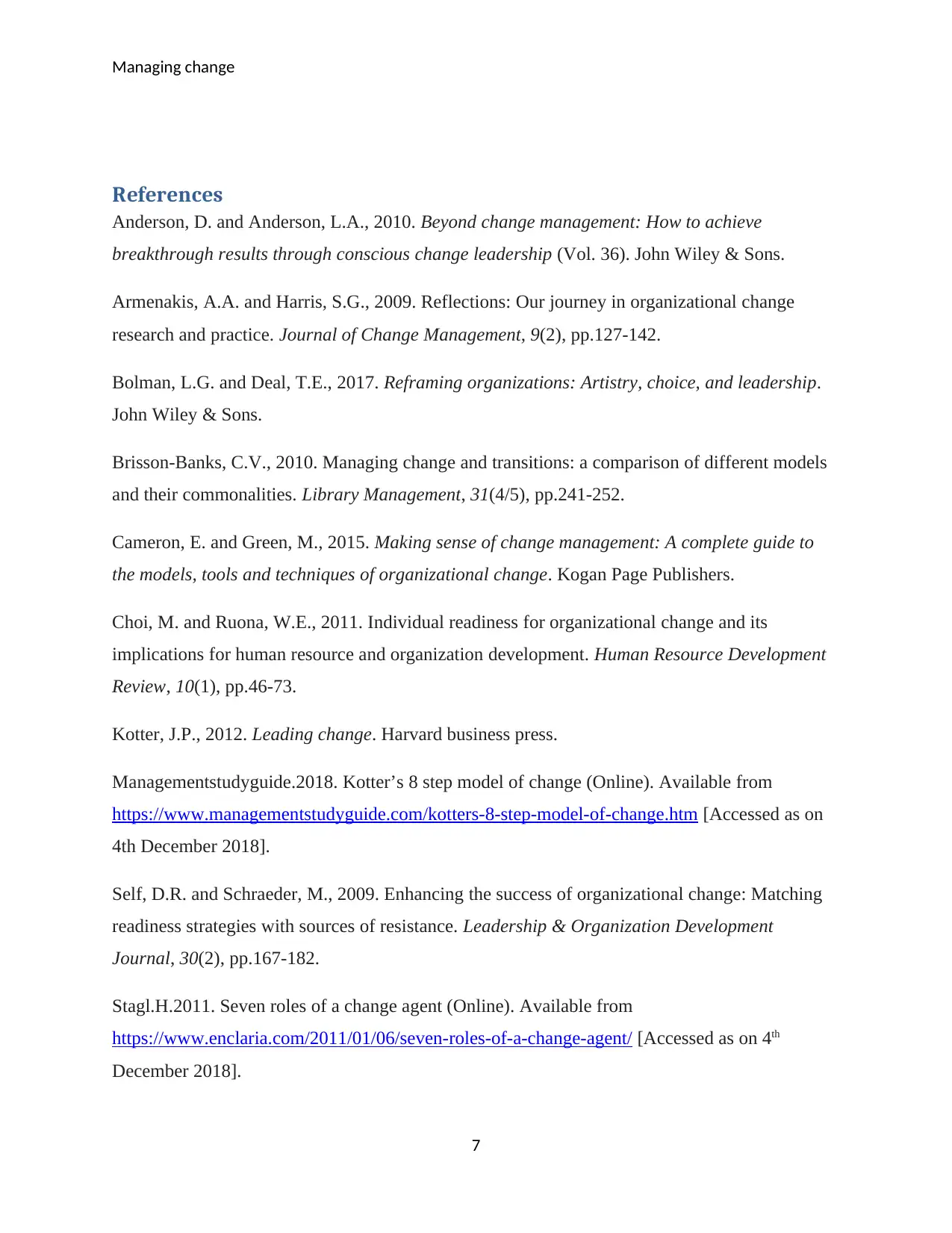
Managing change
References
Anderson, D. and Anderson, L.A., 2010. Beyond change management: How to achieve
breakthrough results through conscious change leadership (Vol. 36). John Wiley & Sons.
Armenakis, A.A. and Harris, S.G., 2009. Reflections: Our journey in organizational change
research and practice. Journal of Change Management, 9(2), pp.127-142.
Bolman, L.G. and Deal, T.E., 2017. Reframing organizations: Artistry, choice, and leadership.
John Wiley & Sons.
Brisson-Banks, C.V., 2010. Managing change and transitions: a comparison of different models
and their commonalities. Library Management, 31(4/5), pp.241-252.
Cameron, E. and Green, M., 2015. Making sense of change management: A complete guide to
the models, tools and techniques of organizational change. Kogan Page Publishers.
Choi, M. and Ruona, W.E., 2011. Individual readiness for organizational change and its
implications for human resource and organization development. Human Resource Development
Review, 10(1), pp.46-73.
Kotter, J.P., 2012. Leading change. Harvard business press.
Managementstudyguide.2018. Kotter’s 8 step model of change (Online). Available from
https://www.managementstudyguide.com/kotters-8-step-model-of-change.htm [Accessed as on
4th December 2018].
Self, D.R. and Schraeder, M., 2009. Enhancing the success of organizational change: Matching
readiness strategies with sources of resistance. Leadership & Organization Development
Journal, 30(2), pp.167-182.
Stagl.H.2011. Seven roles of a change agent (Online). Available from
https://www.enclaria.com/2011/01/06/seven-roles-of-a-change-agent/ [Accessed as on 4th
December 2018].
7
References
Anderson, D. and Anderson, L.A., 2010. Beyond change management: How to achieve
breakthrough results through conscious change leadership (Vol. 36). John Wiley & Sons.
Armenakis, A.A. and Harris, S.G., 2009. Reflections: Our journey in organizational change
research and practice. Journal of Change Management, 9(2), pp.127-142.
Bolman, L.G. and Deal, T.E., 2017. Reframing organizations: Artistry, choice, and leadership.
John Wiley & Sons.
Brisson-Banks, C.V., 2010. Managing change and transitions: a comparison of different models
and their commonalities. Library Management, 31(4/5), pp.241-252.
Cameron, E. and Green, M., 2015. Making sense of change management: A complete guide to
the models, tools and techniques of organizational change. Kogan Page Publishers.
Choi, M. and Ruona, W.E., 2011. Individual readiness for organizational change and its
implications for human resource and organization development. Human Resource Development
Review, 10(1), pp.46-73.
Kotter, J.P., 2012. Leading change. Harvard business press.
Managementstudyguide.2018. Kotter’s 8 step model of change (Online). Available from
https://www.managementstudyguide.com/kotters-8-step-model-of-change.htm [Accessed as on
4th December 2018].
Self, D.R. and Schraeder, M., 2009. Enhancing the success of organizational change: Matching
readiness strategies with sources of resistance. Leadership & Organization Development
Journal, 30(2), pp.167-182.
Stagl.H.2011. Seven roles of a change agent (Online). Available from
https://www.enclaria.com/2011/01/06/seven-roles-of-a-change-agent/ [Accessed as on 4th
December 2018].
7
Paraphrase This Document
Need a fresh take? Get an instant paraphrase of this document with our AI Paraphraser
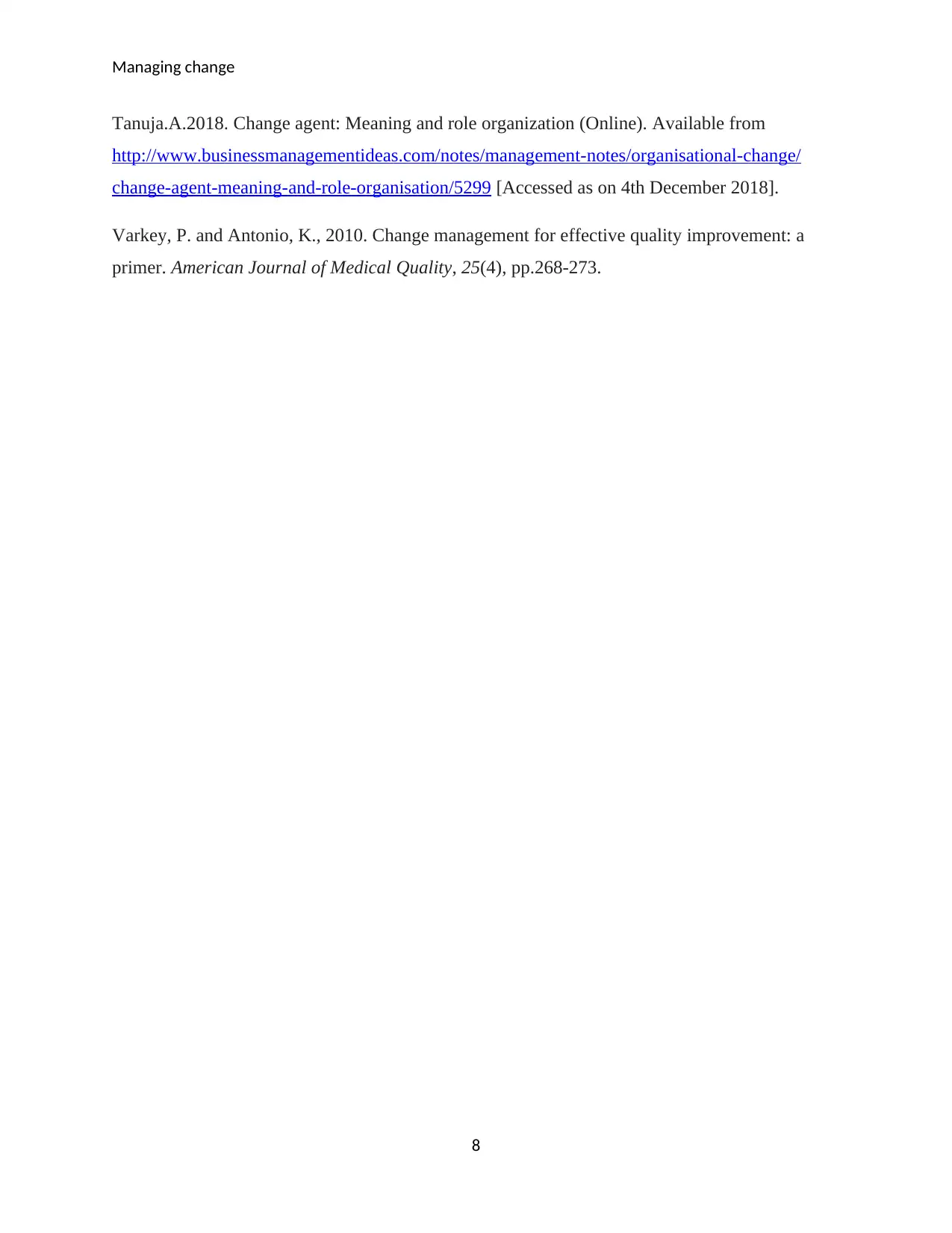
Managing change
Tanuja.A.2018. Change agent: Meaning and role organization (Online). Available from
http://www.businessmanagementideas.com/notes/management-notes/organisational-change/
change-agent-meaning-and-role-organisation/5299 [Accessed as on 4th December 2018].
Varkey, P. and Antonio, K., 2010. Change management for effective quality improvement: a
primer. American Journal of Medical Quality, 25(4), pp.268-273.
8
Tanuja.A.2018. Change agent: Meaning and role organization (Online). Available from
http://www.businessmanagementideas.com/notes/management-notes/organisational-change/
change-agent-meaning-and-role-organisation/5299 [Accessed as on 4th December 2018].
Varkey, P. and Antonio, K., 2010. Change management for effective quality improvement: a
primer. American Journal of Medical Quality, 25(4), pp.268-273.
8
1 out of 8
Related Documents
Your All-in-One AI-Powered Toolkit for Academic Success.
+13062052269
info@desklib.com
Available 24*7 on WhatsApp / Email
![[object Object]](/_next/static/media/star-bottom.7253800d.svg)
Unlock your academic potential
Copyright © 2020–2025 A2Z Services. All Rights Reserved. Developed and managed by ZUCOL.





